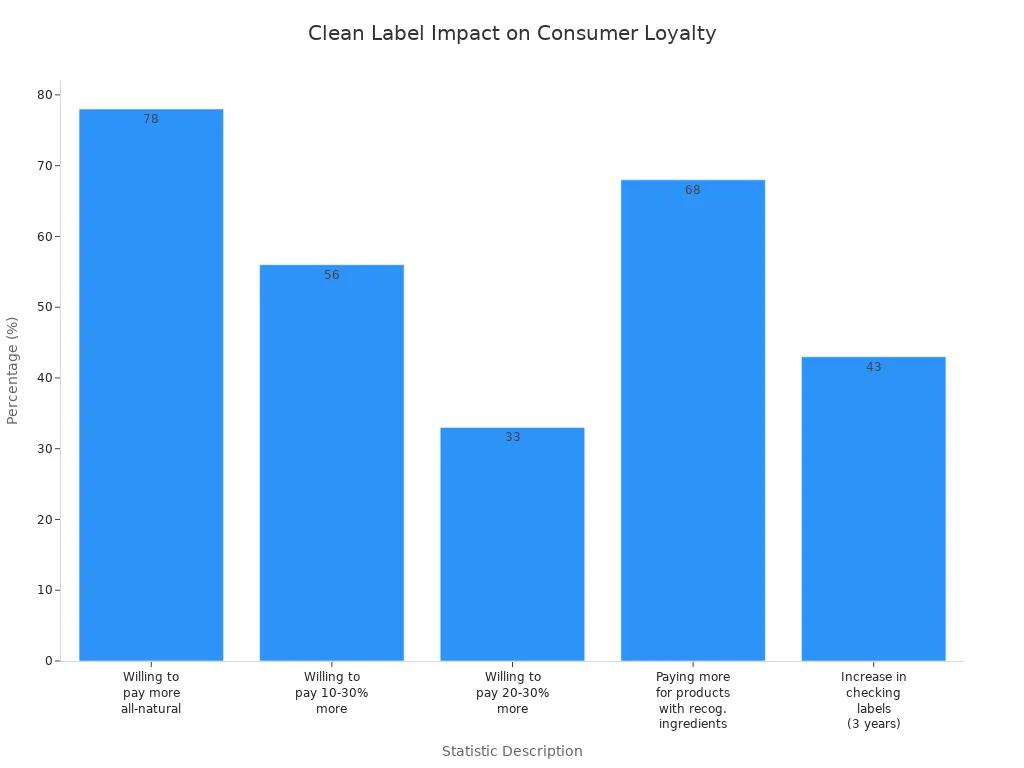
Author: The CUIGUAI Flavor R&D Team | Date: Aug 24, 2025

A Colorful Symphony of a Bountiful Breakfast: A Feast for the Taste Buds from Fruits to Baked Goods
Premium Food Flavors inspire product innovation and foster deep consumer loyalty by delivering exceptional taste experiences. Taste consistently ranks as the strongest purchase motivator in food and beverage decisions:
High-quality ingredients and expert flavor formulation help brands build trust, create emotional connections, and stand out in a crowded market.

Spice Spectrum: A Visual Journey Through Flavorful Seasonings
Premium Food Flavors set products apart in a crowded market by delivering exceptional taste and memorable experiences. The food industry does not enforce strict regulations for labeling flavors as premium or gourmet. Brands use these terms as marketing strategies to signal quality and exclusivity. Consumers define premium food flavors based on several criteria:
Millennials and Gen Z show strong interest in premium food flavors, seeking both experience and health benefits. The COVID-19 pandemic accelerated the premiumization trend, with more consumers looking for comfort and indulgence at home. Brands that focus on quality over quantity and offer artisanal, unique flavor experiences gain a competitive edge.
Note: There is no official regulatory standard for premium flavor labeling. Consumer perception and branding drive the premium segment, making authenticity and transparency essential for building trust.
Unique flavor profiles play a vital role in product differentiation. Brands create custom flavors tailored to regional preferences, dietary trends, and processing conditions. This approach allows products to appeal directly to target consumers. High-quality and natural flavor ingredients help manufacturers develop signature tastes that leave lasting impressions.
Consumers crave both comfort and adventure in their food choices. Nostalgic flavors like vanilla bean and cinnamon sugar provide emotional anchors, while bold global flavors offer excitement and exploration. Brands must balance familiar tastes with innovative combinations to meet evolving consumer expectations.
Social media influences consumers to try new flavors, with younger demographics leading the demand for adventurous and multi-dimensional tastes. Nearly half of Millennials consider unique flavors to make snacks more indulgent, and over 90% of Gen Z and Millennials actively seek novel taste experiences.
Premium Food Flavors create value by elevating product quality and brand reputation. High-quality ingredients lead to superior flavor, consistency, and health appeal. Consumers recognize products made with premium ingredients and distinguish them from those with fillers. This recognition drives repeat purchases and builds brand trust.
Health-conscious buyers demand natural, minimally processed foods free from artificial additives. Sustainable sourcing appeals to eco-conscious consumers, further justifying premium pricing. Investing in high-quality ingredients and transparent labeling is a strategic choice that supports product differentiation and long-term brand growth.
| Criteria for Premium Food Flavors | Consumer Impact |
| High-quality, sustainable ingredients | Drives repeat purchases and loyalty |
| Exotic and global flavor profiles | Attracts adventurous consumers |
| Clean label and transparency | Increases willingness to pay a premium |
| Artisanal production methods | Enhances perceived value and exclusivity |
Premium Food Flavors enable brands to create products that stand out, resonate emotionally, and command higher prices. By focusing on quality, innovation, and transparency, companies build lasting relationships with consumers and secure their position in the marketplace.
Flavor innovation drives successful product launches and keeps brands relevant in a fast-changing market. Companies monitor consumer preferences and adapt quickly to new trends. Today’s consumers expect more than just good taste—they want experiences that match their lifestyles and values.
Consumers also gravitate toward nostalgic flavors like birthday cake and hot chocolate, which offer comfort during stressful times. Adventurous palates explore ethnic fusion, such as Japanese-Italian or English-Indian blends. Trending combinations like sweet and spicy (“swicy”), sweet and smoky (“swokey”), and unique salts or peppers add excitement. Health and wellness trends continue to shape flavor innovation, with a focus on mood-enhancing and indulgent profiles in healthier formats.
Research and development teams collaborate with flavor partners to accelerate innovation. These partnerships bring together diverse expertise, shared resources, and advanced technology. By breaking down silos, teams solve complex challenges that go beyond in-house capabilities. Collaborative ecosystems unite ingredient suppliers, product developers, and scientific societies. This approach speeds up the innovation process, reduces risk, and improves productivity.
Frequent communication and clear mission alignment ensure that everyone works toward shared goals. Leadership commitment and transparent information sharing build trust and resilience. Access to broader data sets and multiple perspectives sparks creativity and better problem-solving.
Brands use advanced tools like artificial intelligence to stay ahead of market shifts. AI analyzes large datasets of flavor compounds and consumer feedback, suggesting novel and appealing combinations. Predictive modeling simulates flavor interactions, reducing the need for physical trial-and-error. AI also recommends smart ingredient substitutions, helping teams maintain quality and compliance.
Digital platforms such as Flavor Studio streamline product development. These platforms consolidate ideation, formulation, testing, and consumer research into one cloud-based system. Teams make data-driven decisions faster, reducing time-to-market and ensuring high-quality, consumer-relevant innovations.
Collaboration between industry leaders and technology partners, such as the partnership between McCormick and IBM Research, demonstrates how combining sensory data with AI can identify new flavor possibilities and optimize formulas. This approach increases the likelihood of successful product launches and helps brands respond quickly to changing consumer demands.
Consistency in taste defines a brand’s reputation and builds consumer trust. Reliable flavor systems ensure that every product batch delivers the same sensory experience, regardless of where or when it is produced. Manufacturers achieve this by implementing rigorous quality control measures and standardized processes.
Consistency in taste not only meets consumer expectations but also supports product authenticity. When customers know they can rely on a familiar flavor profile, they are more likely to become repeat buyers and brand advocates.
Clean label solutions have become a cornerstone of modern food manufacturing. Consumers now demand transparency, simplicity, and natural ingredients in their food choices. Brands respond by reformulating products to eliminate artificial additives and by providing clear, honest labeling.
Brands like CUIGUAI Flavor food-grade flavoring support clean label compliance by sourcing high-quality ingredients, maintaining strict quality control, and training staff to uphold transparency and safety standards. These practices help brands confidently offer products that meet consumer expectations for honesty and healthfulness.
Reducing additives aligns with both regulatory requirements and consumer preferences. The U.S. Food and Drug Administration (FDA) defines natural flavors under 21 CFR 101.22 as substances derived from natural sources, used primarily for flavoring rather than nutrition. Products must clearly identify natural flavors on ingredient panels, and if the main flavor comes from natural sources rather than the actual food, the label must specify this.
Clean label solutions and reduced additives not only meet regulatory and health standards but also enhance perceived product value. Brands that prioritize these practices build lasting loyalty and differentiate themselves in a competitive market.

Gratitude in Business: A Simple Thank You
Superior flavors play a crucial role in driving repeat purchases and building lasting consumer loyalty. Taste stands as the primary reason for purchase, with 88% of consumers identifying it as the main driver when choosing food products. Brands that deliver unique and crave-worthy flavors create memorable experiences, encouraging customers to return for more.
Consumers often seek complex, balanced flavor profiles that provide memorable sensory experiences. These experiences foster brand loyalty and habitual use. Emotional connections tied to flavor deepen this loyalty, making products a regular part of consumers’ lives. Brands that continuously introduce new flavors and engage consumers in the innovation process—such as allowing them to vote on new varieties—see increased involvement and repeat purchases.
Brands that prioritize flavor quality and innovation not only retain existing customers but also transform them into brand advocates.
Premium Food Flavors justify higher price points by delivering superior taste and quality. Consumers recognize the value of products made with high-quality ingredients and are willing to pay more for an elevated sensory experience. This willingness to pay a premium stems from the perception that these products offer something unique and memorable.
A table below summarizes how perceived value supports premium pricing:
| Factor | Impact on Premium Pricing |
| Superior flavor quality | Justifies higher price |
| Unique and memorable profiles | Increases willingness to pay |
| Clean label and transparency | Enhances perceived product value |
| Artisanal production methods | Supports exclusivity and pricing |
Brand storytelling centered on flavor innovation strengthens emotional connections and deepens consumer loyalty. When brands share the origins, cultural significance, and creative processes behind their flavors, they build trust and authenticity. These stories transform products from simple commodities into meaningful experiences.
Taste innovation turns everyday products into enjoyable rituals, making them a memorable part of consumers’ routines. Collaborations with chefs, influencers, and community members add authenticity and foster a sense of belonging. Transparency about ingredient quality and brand heritage further strengthens trust and loyalty.
Emotional loyalty goes beyond discounts or convenience. Brands that exceed expectations and align with consumers’ values—such as sustainability and authenticity—build deeper, more resilient relationships. Emotional attachment leads to passionate feelings and a sense of irreplaceability, which sustains loyalty even during challenging times.
Premium Food Flavors, when paired with compelling brand stories and emotional resonance, create powerful connections that drive repeat purchases and justify premium pricing. Brands that invest in these strategies secure long-term growth and a loyal customer base.
Premium Food Flavors support long-term brand growth by enabling companies to stand out in a crowded marketplace. Brands like McCormick & Company show how strong flavor solutions can drive stable revenue and scalable production. Their diversified approach across consumer and industrial markets helps them manage changes in demand. Lindt & Sprüngli demonstrates that a focus on artisanal quality and luxury positioning protects profit margins and builds loyal customer bases. Even when ingredient costs rise, these brands maintain solid results through pricing power and customer loyalty. Private label brands such as Kroger and Costco’s Kirkland Signature also benefit from premium flavor strategies. Over 90% of Kroger’s customers purchase their private label products, showing deep trust and preference. These brands often achieve higher profit margins and greater negotiating power with suppliers.
Premium Food Flavors allow brands to create unique products, foster consumer trust, and secure a strong position for future growth.
Investing in premium flavors helps brands adapt to changing consumer preferences and reduce business risks. Consumers now seek unique, natural, and organic flavors, and they are willing to pay more for these options. Companies that offer premium flavors can quickly respond to trends like plant-based, keto-friendly, and sugar-free diets. This flexibility reduces the risk of products becoming outdated. Brands that focus on clean-label and sustainable ingredients maintain consumer trust, even as regulations and market demands shift. Many companies use artificial intelligence and machine learning to track consumer preferences in real time. This technology helps them adjust flavor offerings quickly, keeping products relevant and reducing the risk of lost sales.
By staying ahead of trends and focusing on health-conscious, authentic flavors, brands can protect themselves from sudden changes in the market.
Brands can take several steps to leverage premium flavor solutions for growth and market relevance:
| Step | Benefit |
| Collaborative R&D | Unique, tailored flavor profiles |
| Sensory testing | Improved flavor performance |
| Regulatory support | Market readiness and compliance |
| Community engagement | Increased loyalty and feedback |
| Digital storytelling | Enhanced brand perception |
Brands that follow these steps can create memorable flavor experiences, build strong customer relationships, and maintain a competitive edge.
Illustrations of flavor innovation help readers visualize how premium flavors transform products and drive market success. These visuals can showcase the creative process behind developing new taste experiences, from ingredient selection to final formulation. For example:
The interplay of flavors and colors in these products creates harmonious sensory experiences. When flavor and color match, consumers feel satisfied and are more likely to become repeat buyers. This sensory harmony reinforces authenticity and sophistication, helping brands stand out.
A well-designed illustration can highlight how these innovations integrate taste, function, and authenticity, making the impact of premium flavors clear and memorable.
Consumer taste testing is a critical step in validating flavor solutions. An illustration of this process can clarify best practices and show how brands ensure their products meet consumer expectations. The following steps outline a typical taste testing protocol:
An illustration of consumer taste testing in action, placed in the Innovation in Flavor Development or Quality Flavor Solutions and Consistency sections, can help readers understand how brands use structured feedback to refine flavors and ensure product success.
Collaborative research and development (R&D) drives the creation of successful premium food flavors. An illustration of this process can depict how multidisciplinary teams work together to unlock new taste experiences. For instance, the Precision Indoor Plants consortium brings together academic, government, and industry experts to breed strawberry varieties for indoor agriculture. This partnership combines molecular research, innovative breeding, and advanced cultivation techniques to produce flavorful, nutritious crops year-round.
By pooling resources and expertise, collaborative R&D accelerates the development of premium flavors tailored to specific market needs. An illustration of this process, featured in the mid-post, can highlight the teamwork and innovation that underpin the most successful flavor solutions.
Brands that invest in premium food flavors need clear ways to measure the impact on consumer loyalty. Loyalty metrics help companies understand how well their flavor strategies build lasting relationships and drive business growth. These metrics capture both behavioral patterns and emotional connections, offering a complete view of brand performance.
Premium flavor solutions often lead to higher repeat purchase rates. This metric shows the percentage of customers who return to buy the same product again within a set period. A high repeat purchase rate signals strong satisfaction and trust in the brand’s flavor quality. Purchase frequency, or how often a customer buys, also reflects the strength of loyalty. When customers choose a brand’s products more often, it shows that the flavors meet or exceed their expectations.
Customer retention rate measures the percentage of customers who stay with a brand over time. Brands with consistent, high-quality flavors tend to keep more customers, reducing the need for costly new customer acquisition. Net Promoter Score (NPS) is another key indicator. It measures how likely customers are to recommend a brand to others. A high NPS suggests that consumers feel confident in the brand’s flavor offerings and are willing to advocate for it.
Customer lifetime value (CLV) predicts the total revenue a brand can expect from a single customer throughout their relationship. Premium flavors that foster loyalty increase CLV, as satisfied customers tend to spend more and stay longer. Share of wallet, or the portion of a customer’s spending in a category that goes to one brand, also rises when flavors stand out from competitors.
Qualitative insights add depth to these numbers. Brands analyze customer feedback, sentiment, and brand associations to understand emotional connections. Positive feedback about flavor quality, authenticity, and innovation often signals strong loyalty. These insights help brands refine their flavor strategies and strengthen consumer bonds.
Brands that track these loyalty metrics can quickly spot trends, address issues, and celebrate successes. This data-driven approach supports continuous improvement and long-term growth.
| Metric | Description | Importance |
| Repeat Purchase Rate | Percentage of customers making repeat purchases | Indicates customer satisfaction and loyalty |
| Customer Retention Rate | Percentage of customers retained over a period | Reflects brand loyalty and satisfaction |
| Net Promoter Score (NPS) | Measure of customer loyalty and satisfaction | Indicates likelihood of customer advocacy |
| Customer Lifetime Value (CLV) | Total value contributed by a customer over time | Reflects long-term customer loyalty |
| Customer Feedback Analysis | Qualitative insights into customer satisfaction and sentiment | Provides understanding of emotional connection |
By illustrating these loyalty metrics, brands can showcase the tangible benefits of premium flavor solutions. These measurements not only highlight success but also guide future innovation and investment in flavor excellence.
Premium Food Flavors deliver strategic value by fueling innovation, building emotional connections, and supporting clean label practices. Brands that prioritize superior taste and transparency see higher repeat purchases and premium pricing. Research shows that 83% of consumers recognize clean label products, and 78% are willing to pay more for all-natural options.
| Statistic Description | Value/Percentage |
| Consumers recognizing clean label products | 83% |
| Willingness to pay more for all-natural products | 78% |
| Increase in consumers checking ingredient labels (3 years) | 43% |
Case studies like Zico Coconut Water and Chobani highlight how flavor innovation and storytelling drive market success. Ongoing collaboration with flavor experts ensures brands stay ahead of trends and maintain product excellence.
Brands should invest in robust flavor strategies, continuous consumer research, and strong partnerships to secure long-term growth and loyalty.
Premium food flavors use high-quality ingredients and deliver unique, memorable taste experiences. Brands often highlight artisanal methods, global inspiration, and clean label practices to signal premium quality.
Superior flavors create emotional connections and encourage repeat purchases. Consumers trust brands that consistently deliver enjoyable taste experiences, which strengthens loyalty and increases lifetime value.
Clean label practices build consumer trust by ensuring transparency and natural ingredients. Shoppers prefer products with simple, recognizable components and avoid artificial additives.
Brands use standardized recipes, rigorous quality control, and sensory testing panels. These steps guarantee that every batch matches the expected flavor profile and meets consumer expectations.
Research and development teams collaborate with flavor experts to create new profiles, adapt to trends, and solve technical challenges. This process helps brands stay competitive and relevant.
Consumers associate premium flavors with quality and authenticity. They are willing to pay more for products that offer superior taste, clean labels, and unique experiences.
Brands track metrics like repeat purchase rate, customer retention, and Net Promoter Score. They also analyze feedback to understand emotional connections and satisfaction.
Global inspiration, health-focused ingredients, and mood-enhancing profiles drive innovation. Brands respond to consumer demand for adventurous, functional, and nostalgic flavors.
Copyright © 2025 Guangdong Unique Flavor Co., Ltd. All Rights Reserved.